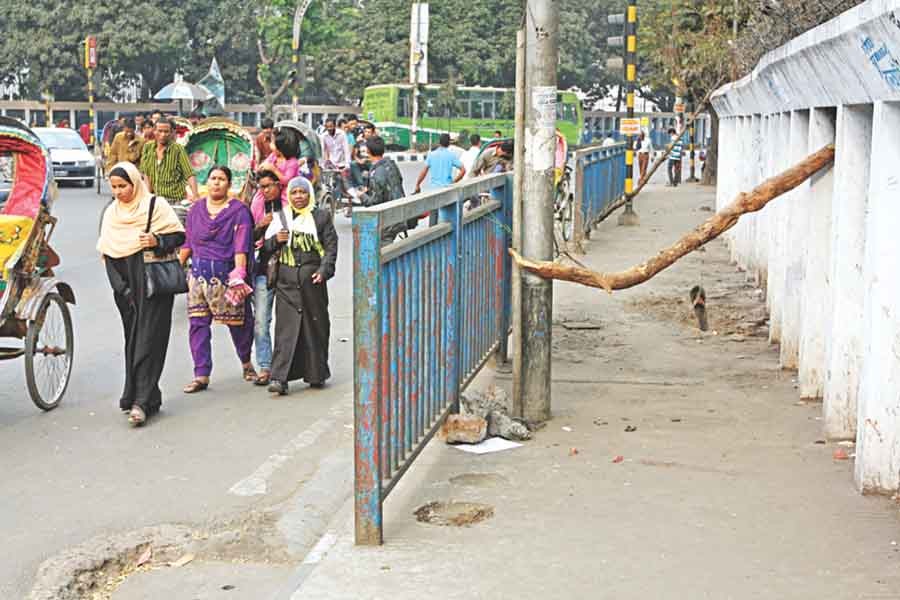
Published :
Updated :

A sidewalk, footpath in Bangladesh, is meant for safe pedestrian movement. It saves passersby from being hit by speeding automobiles. Finding it chockablock with people in rush hours has reasons to make many feel depressed. In the ever-sprawling metropolis of Dhaka, this scenario has lately become quite common. Print media photographs and TV footage these days graphically portray this state of Dhaka footpaths. They show how pedestrians struggle desperately to make room for just setting their foot on a sidewalk in many areas of the city, where feeble people are seen being inadvertently elbowed out into the corners. These days some footpaths are fenced with iron bars resulting in the increase of the pedestrians' sufferings. To avoid being constantly pushed by others from behind, many are found walking nonchalantly along the edge of the main roads filled with vehicles.
A lot of busy spots in the stiflingly crowded city experience such frenzied movements on footpaths. The areas include those in Farmgate, Shahbagh, Elephant Road, Paltan-Motijheel, Gulistan, Bangshal and some sections in Gulshan and Uttara. The feverish movement of pedestrians prompts a large number of women to carefully shun footpaths, exposing them to minor and major road accidents. The same applies to the elderly.
To call Dhaka's footpaths merely overburdened is understatement. With the passing of time, these passages, meant exclusively for pedestrians, are increasingly becoming fraught with unbearable discomforts. Apart from the difficulty moving smoothly, the footpath users have to put up with the hazards of pick-pocketing, being helpless victims of cheats, and, even, mugging. Incidents of young women being indecently touched in a thick footpath crowd have become common in some specific areas. These women prefer not to be vocal about the harassment and go on suffering. For children not used to moving amid crowd, a walk along a busy footpath becomes a dreadful experience. Many of them get hurt while moving.
The whole episode turns into a horrendous one with the presence of hawkers or vendors. Their roadside business activities make the normally narrow footpaths narrower.
Not long ago, these sidewalks meant for pedestrians were spacious and quite user-friendly. As days wore on, the footpaths appeared to be turning narrower. In fact, this state of the footpaths had more to do with the rise in the city's population. The unabated increase in the pressure of people moving on foot has made the sidewalks look squeezed and narrower by the day. Moreover, in order to increase the main roads' width, footpath space has been encroached on in many parts of the capital. The narrowing of space for Dhaka's footpaths is, thus, not an isolated feature. In view of the entire sloppily managed metropolis, the narrow footpaths resulting in the pedestrians' myriad inconveniences appear to be nothing unusual. Thanks to the continued decline in the city's urban amenities, its people seem to be destined to move along narrow and overcrowded footpaths. It is all but a normal urban ordeal in Dhaka.
Given their awful state lately, many might bring into question the rationale behind attempts to enforce rules that compel pedestrians to walk on footpaths. Disorderly and chaotic pedestrian movement on the edges of the main roads should be prevented with stringent laws. It's not only a bad practice; it invites the spectre of being hit by running vehicles. But on herding the pedestrians into footpaths, could the authorities ensure their safe and hazard-free movement? Many footpaths in the city have been cleared of hawkers. Yet a lot of people do not feel inclined to use them due to their overcrowded state. Similar spectacles are encountered on many over-bridges in the busy areas. Urban infrastructure authorities can ill afford to sidestep this largely overlooked problem.


 For all latest news, follow The Financial Express Google News channel.
For all latest news, follow The Financial Express Google News channel.